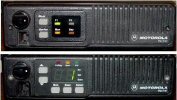
|
|
Exploring 900 MHz - Radios for 900 MHz / 33 Centimeters & Their Modifications |
(A loose compilation of notes always undergoing editing - Please mirror, link to, reprint as desired)
History
The 33 centimeter ham radio band was born in 1985. The FCC allocated 902 to 928 MHz to ISM (Industrial, Scientific, and Medical) devices. As part of that proceeding, the band was also allocated to the Amateur Radio Service on a secondary basis. This means hams can use the band as long as they accepted interference from and did not cause interference to this primary user. Part 18 ISM devices utilize RF energy for non-communicative purposes. They radiate only and do not receive therefore it is highly unlikely that you would ever interfere with an ISM device. There are a couple other secondary users we need to be aware of as we may not cause harmful interference to, and not receiving any interference protection from automatic vehicle monitoring systems, and Government stations authorized in this band.
Sources of Interference
About 5 years after this chunk of spectrum was carved out, many cordless phones started to appear on the lower and upper ends of the 900 MHz centimeter band. Prior most of the cordless phone were operating in the 46 MHz region, but that was becoming over-crowded. It was also around this time that wireless computer networking was becoming a concept. Several companies created products that also utilized this bandspace. The most popular was probably Lucent WaveLAN. It should be noted that cordless phones and wireless LAN products are Part 15 devices that just happen to be operating on an older more established ISM (Part 18) band. These products are Not Part 18 devices. Part 15 devices must not interfere with primary or secondary users (Part 15 operation is always subject two conditions: This device may not cause harmful interference. This device must accept any interference received, including interference that may cause undesired operation.)
What's 900 MHz like?
Band characteristics are pretty similar to 70 centimeters (440 MHz) in terms of local propagation and in some ways better.. A lot of hams actually have some experience in nearby spectrum 800-MHz cell phones. That and monitoring 800-MHz trunked public-safety radio. You get the expected faster mobile flutter or picket-fencing on noisy signals (just as 70 centimeters is faster than 2 meters) due to the extremely short wavelength. Multipath propagation is much more pronounced on this band than 440. This is where a RF signal can take different paths when propagating from a source to a destination. Objects that get in the way, cause the signal to bounce in different directions. This is not necessarily a disadvantage, as it results in great building penetration. Simplex may be pretty pathetic. However, if you can get a repeater up in the air with a good antenna and feedline, itís going to work quite well. Unfortunately there are NO off-the-shelf 33cm radios on the amateur market, most likely due to the lack of international allocations for this band. This is a band that's wide open to the experimenter and it awaits exploring and exploiting. The band is ours (subject to sharing limitations) and we should use it, even though we will suffer some problems from time to time with other services.
Bandplan
While the national band plan as well as many state band plans call for a -12 MHz split for FM repeaters, an increasing number of states are changing their band plans to reflect the growing number of FM repeaters using -25 MHz splits. Many amateurs feel that eventually the -25 MHz split will become commonplace and all state and national band plans will adopt it. (see this note). This is because the commercial 900 gear uses 890-896/935-941 MHz with a -39 MHz split. Naturally 900 MHz gear for ham use is hard to come by, so equipment availability is probably the biggest advantage to the 25 MHz split. And what is out there works better at the band edges closer to where it was designed to operate. Although theoretically, it is also easier to achieve the necessary isolation for full duplex (repeater) using 25 MHz vs 12 MHz split. Also, seems to be easier to find duplexers that do 25 MHz easily, without adding cans. For the user end radio's basically at 927 MHz your okay, 926 your still not bad, but at 921 MHz you're not so good, like 10-15 db down or more. 915 is more like 40 dB down, and 902 is just as bad. Replacing receive filters can help this situation greatly. After a filter change on just about any radio you can expect .175 uV to .23 uV across the band. Hams have also found that using 12.5kHz channel spacing helps cut down on interference potentials from he unlicensed Part 15 devices such as cordless phones. (see this note) +/-2.5kHz maximum deviation is also a standard.
https://groups.io/g/AR902MHz/
This listserv is used to further experimentation and utilization of the
902-928Mhz amateur radio spectrum using voice and data communications. Please
limit your posts to information relating to these subjects ONLY. Want and
For-Sale ads allowed. Do not post EBAY links. Do NOT list non-900Mhz applicable
items.
https://groups.io/g/900MHz
For those interested in utilizing the 900 Mhz amateur radio band. This group is
here to discuss modification of commercial radio gear to amateur radio use,
repeater construction for 900 Mhz, and other related topics relating to the 900
Mhz amateur radio band.
http://mailman.qth.net/mailman/listinfo/33cm
33cm is a mailing list reflector devoted to the discussion of the 33cm
amateur band.
* DX and Weak Signals, Current Propagation, Activities on 33cm,
Anything 33cm Related
http://batboard.batlabs.com/viewforum.php?f=3
Converting Motorola Equipment to 900MHz Amateur
OhioAPRS 902Mhz Repeater Directory - An excellent directory. As many systems are 25 MHz split but some state bandplans are still call for 12 MHz splits, you might have trouble coordinating and in effect listing your system in traditional sources like the ARRL repeater directory..
For simplicity of setup ( as in minimal or no hardware mods) you
are basically limited to the following, much of the information below was
compiled from the above discussion lists.
Motorola GTX 900 Portables and Mobiles.
GE 900 MHz MPA/MTL Portable.
Kenwood TK981 and TK481 900 radios.
Motorola MCS2000 Mobile 900 version
Motorola MTX9000 portable. 900 model
Motorola Professional series 9250 (MTX9250)
For another good overview see the Guildford Radio Society's 900 MHz technical guide. And for a great overview of information specific to Kenwood radios on 900 MHz, see Alex, KD6VPH's site. http://www.kw902.com/
900 MHz Motorola Maxtrac Mobile's (models starting with D27 or D37)
(Preferably with conventional firmware)
Note: NOT 800 MHz Maxtrac's, or other 900 MHz models, these are not capable for
902-928 MHz conversion. See: Modify the VCO stripline, and front end
filters & reprogram.

MaxTrac
900 MHz Model Information By Repeater-Builder Staff - a break down of
model numbers
Converting
an 800 MHz talkaround MaxTrac to a 902 MHz Repeater Receiver
Expect .25 uV sensitivity with jumpered filters or .28 uV with replaced 915 MHz
filters.
After receive filter changes you can expect squelch to break at 0.14 uV with full
quieting at 3.97 uV
toko915.jpg TOKO 915 MHz RX filters,
6DFB-915E-10 and 4DFB-915E-10 for MaxTracs
Replacing
Front End Filters in MaxTrac 800 / 900 MHz Radios
Interfacing
a MaxTrac to a repeater controller
Simple -
Interfacing MaxTrac Transceivers to Repeater Controllers
Maxtrac 900 MHz Conversion
- Batlabs
Extending
the Maxtrac 900 MHz VCO Frequency Range
maxtrac mods.txt Info and description on 900
Maxtrac VCO Mods
Below are details on the 900 power
control modifications. Handy if your using the Maxtrac as an exciter.
Max_power-1.jpg resistors to remove
Max_power-2.jpg 10-50k pot
Max_power-3.jpg 10k pot installed
Max_power-4.jpg Transmit +9v location
900 MHz Motorola GTX900 Mobile / Portable (The ones that are going to be able to
do ham start with the model #M11W for mobiles or H11W for handhelds).
All you have to do is change the bandsplits in the gtx.mdf using the same
procedure as detailed on the Maxtrac/Radius page to something that covers the
Ham band, and program the radio.

The GTX radio is not as popular or easy to find as the MaxTrac, but it is well built (MIL SPEC) and easy to modify for limited 900 MHz band coverage. The factory MaxTrac receiver is almost deaf below 928, making the hardware hack necessary. In terms of programming, the MaxTrac can go from 800 to 999 and can be hardware modified almost the same. The factory GTX will receive down to around 925 with a simple software hack. If your looking to work only repeaters, then this is the 900 radio for you. This is also true for the GTX 900 Handheld.
GTX 900 MHz Radio Information, Notes, and Tips
GTX 900 MHz Amateur Radio
Conversion
AA2LS GTX Ham mod notes
An overview of the 900 MHz GTX mobile and handheld
Bit-Banging the GTX
RSS for 900 amateur service
http://n1su.com/900.html - Suggestions for getting started with this radio
Typically the GTX mobile you're able to get 11.2W - 13.0 W TXPO for 902-903 and 927-928. And 2.5-3.0W in these ranges with the portable. For both mobile and portable the deviation is slightly more stable (avg of 4KHz) and high end sensitivity is about 0.25uV for 12dB SINAD. Again, they are DEAF on 902-903 MHz, but it doesn't matter as this is repeater input spectrum. Low end RX sensitivity is about 3-4 uV
A common problem in GTX's is output power fluxuations. Usually it appears
that the final amplifer is not engaging. This behavior is different from radio
to radio and between different frequencies. The reason is the power control
circuitry uses an algorithm based on the test frequencies stored in the radio.
Since 902 is very close to the original range, it works OK. With 927, it is
getting messed up because that frequency isn't close to one of the test
frequencies.
Per N9LLO: The simplest cure to this problem is by cloning in a code plug from
another GTX that didn't exhibit the problem.
After you get the "magic" code plug, you need to clone it into your
GTX mobile. The RSS will want to also see system ID file. Without this special
file, you will not be able to clone your radio, even when cloning its own
code plug. RSS will just refused to go further. Quite annoying.
The system key file will have to go into a specific directory/folder and have a
specific name. Somehow this encoded file contains the system ID and other stuff
RSS needs to make sure you really are allowed to change every field in the
trunking info sections. Without it, you can't change any trunking info or
perform a cloning operation.
With this key file, the cloning should go fine, radios tested put out equal
power on 927.4875, 927.5000, and 927.6000. Other reprogrammed channels to ones
liking and have tested been tested on a service monitor. They put out about
11.25 watts +/- 0.25 watts on all the channels one person tested.
Deviation is relatively consistent as well. Else see: Taming
the GTX 900 MHz Mobile Radio's Output Power - A hardware approach
GTX_squelch_detect.jpg
where to pick off HISQDET (~6.6vdc) in the GTX mobiles
gtx900a-COR.jpg
alternative location to pick COR off (Active low)
GTX-PAschematic.jpg
power control main board
gtx-notes.txt
gtx power control & other notes
900_receive_specs.txt
RX performance notes within the ham band on commercial modified gear
MTX-900 Motorola Handie Talkie's
Capable of 902-928 MHz conversion with the Mots6 Mod see: Insert an additional
microprocessor to provide on the fly amateur frequency conversion (these
radios should be available around $50 or less)

http://www.batlabs.com/mtx900.html
Notice that there is now a more modern looking MTX-900. The mots6 mod was for the prior version, the Genesis-series radio, like the HT600 and MT1000. The guess is that it's built for a foreign market, and they've recycled the MTX900 moniker in a place that never had the old one.
MTX-9000 Motorola Handie Talkie's
Capable of 902-928 MHz by hex editing MTSX.ODB file see: http://www.batlabs.com/mtsx.html#2
Just Program / some have problems mods may be necessary, as not
all MTX9000s will stay in lock in the Ham bands - some do, some don't!

The most common programming problem with this particular radio is not having a compatible or version of software to program it. With this one it's common that the codeplug's are not reverse compatible. You should be okay if you have access to V. 6.07.00 software, else you'll need the lab software to re-write it, and it should back up to a pre CPS state with that. Expect about .22uV @ 12db SINAD on the high end. What's interesting about this radio is they are great for experimenting between narrow band and wide band since as that parameter is programmable. It also has an alpha-numeric display.
Motorola MCS2000 Mobile
Capable of 902-928 MHz by hex editing the MTSX.ODB see: http://www.batlabs.com/mtsx.html#2
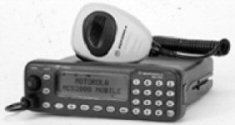
This radio is by far, the best sounding, best audio quality many have played with. A few mods jumpering some pins on the accessory plug may be necessary to get it to operate how you want. Jumper pins 1/2 to get the internal speaker working, 4/9 to disable the "tx on powerup" issue (emergency button) install a jumper in the control-head/ faceplate to always enable the mic hang-up feature. This enables the tone/dpl decoder at all times. TXPO on 927-928 MHz was 31.8W. TXPO on 902 MHz was slightly less, around 24W. The only issue was with the squelch, which seems to have a lot of hysterisis, regardless of how low ones goes (improvements noted) with the squelch level. Setting the squelch to open for 12dB SINAD, it won't close until the signal is completely gone. If you turn it up a value or two, it gets really tight, and won't open until I inject a signal of about 0.4uV. Most set it for the lower value, and use tone-squelch, so no big deal. The radio is DEAF at 902-903. Sensitivity was 0.19uV for 12dB SINAD at 927.5 MHz, so it's a decent beast. Deviation is about 4.0 KHz, and stable. It sounds good with a desk-mic.
Motorola Spectra Mobile (D27 & D37 models)
Hex edit the Spectra1.exe to change the
bandslpits. See here.
You will also need to modify the
VCO. And as usual for best receive the filters should be replaced in
the front end.
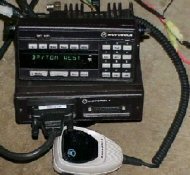
You can get good sensitivity (around .22uv@12db SINAD) by modifying the preselector (front-end filter).
Motorola MTS2000 Portable
Once again you will need to edit the band limits in the MTSX.ODB
file see: http://batlabs.com/mtsx.html#2
This portable has proven to be slightly more tricky to set up. They have issues with squelch hanging open, or being too high, regardless of what you do in the soft-pot menus. If you use tone-squelch, so it's not that big of a problem. Deviation is low with the built-in mic, but is fine with a speaker-mic. It's almost as if the gain for the built-in mic is disabled. Yes, people have checked/played with the gain settings in the service menu. No go. TXPO is a healthy 2.9W, and sensitivity was 0.26uV for 12dB SINAD. "Stable" deviation (across the band) is about 3.4 KHz. Good enough - one can always turn it up later, and sacrifice talk-around once the repeater is up.
Motorola MTX9250 Portable

Hex edit the CPS_95nt.exe to allow amateur programming. Receives well without a filter change. RX sensitivity at 927.9375 is .12 uV, 902.0000 .15uV. It may be advisable to get the CPS lab software as there have been reports that some unlock midband. You can click on the "AUTO TUNE" button in LABS and the software will take off and retune the HT..
Here are the modifications required to the trunking CPS R01.03.06-AA edit the CPS_95nt.exe file as follows:
old string 9428 BB37 new string D410 6835
Change the above at all the following locations
19C74
1A73B
87EB5
8BE58
1FC924
1FC958
1FCB94
1FCBC8
1FCF3C
1FCF70
1FCFA4
1FCFD8
1FD00C
1FD040
Motorola Mototrbo XPR 6580 & XPR 4580 Portable

Hex editing instructions for these Mototrbo 800/900 MHz radios, to put them on the 902/927 MHz analog ham frequencies. Mototrbo is a 2-slot TDMA digital radio format based on the European DMR standard.
Kenwood TK941 Mobile
Just Programming see: W7UVH's notes. Also look at N2MCI's
notes.
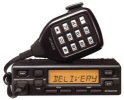
Kenwood's are pretty much unusable without a filter change even with a slight alligator repeater. On the TK941 it took 100uV at 902.6625., while RX sensitivity was fairly good around .25-.30uV at 939.9875 If you want to use the TK941 to receive at 902, you will have to change the filters.
On Kenwood's they are programmed by FCC channel number. The trick is to use FCC channel number 200 in all systems. This will indicate frequency 937.5000. You save this file and exit the Kenwood KPG-25D software (and a KPG-4 program cable). Run a custom program, (Kenwood3.exe or the KW900EZP program) and or a bit of hex editing to be able to use it in the ham band. There is really no way to change the commercial -39 MHz slit for duplex operation. The only way to really use these for duplex is load all of the transmit frequencies should be into one system, each receive frequency will be an individual systems. Select "Last Used" in the program. Select the transmit system and the repeater input you want, turn on the scan and you are ready to transmit. Let up on PTT and the radio scans to the repeater output.
There is only one spot in the saved file to change the freq. data and the rptr. split of 39mhz is fixed in the radio's firmware. This is true even if you edit the data manually. These radio's require you to use 2 systems aka banks to store the Xmit freq. & Rec. freq. separately. When using KW900EZP, program the rec. freq's and also select Transmit Inhibit = Y, the normal defaults for rptr. xmit, and simplex select Talk Around = Y. After you run the saved file through 'EZP, the freq's will now display the correctly and the repeater input freq's have TA enabled in order to allow the freq's to display properly. The TK-431 and TK-941 (mobile) are the least user friendly for the 900MHz band.
Kenwood TK931 Mobile
Just (you may want to change filters) Programming see:
tk931.txt The receiver is about typically about 2
uV on the high end of the band without modification. Also some have
reported at 902 on the TK931 the VCO may not lock on receive without filter
replacement?
Adding a 510k 1/8 watt resistor at a point of where R150, 151 and pin 5 of IC105 will make the squelch receive much more sensitive. That is the point to ground. A new adjustment of the squelch may be required.

Also see http://www.ham-radio.com/wb6zsu/components/receiver/receiver_mods.html
RX sensitivity on the low end with Kenwood's is pretty bad, pretty much unusable without a filter change even with a slight alligator repeater. On Kenwood's they are programmed by FCC channel number. The trick is to use FCC channel number 200 in all systems. This will indicate frequency 937.5000. You save this file and exit program. Run a custom program, (Kenwood3.exe.) and or a bit of hex editing to be able to use it in the ham band. In many Kenwood's there is really no way to change the commercial -39 MHz slit for duplex operation. They have cracked this problem KnwdBurn programs them directly onto the 25 MHz ham band splits. KNWDBURN is a Full Ham replacement program for the TK-931 only / so far.. It replaces using the normal KPG5D programming software.
Kenwood TK481 Portable
Just Programming
![]()
RX sensitivity on the low end with Kenwood's is pretty bad, pretty much unusable without a filter change even with a slight alligator repeater. On Kenwood's they are programmed by FCC channel number. They are fairly easy to deal with, can be directly programmed to 902 927 with modified RSS. Otherwise you will need to write a 937.xxxx file for what needs to be 927.xxxx Then hex edit the radio personality file to change all 937 entries to 927, and all 898 entries to 902 entries...
The trick is to use FCC channel number 200 in all systems. This will indicate frequency 937.5000. You save this file and exit the KPG-49d programming software. Run a custom program, (such as the KW900EZP program) and or a bit of hex editing to be able to use it in the ham band. In many Kenwood's there is really no way to change the commercial -39 MHz slit for duplex operation. They have cracked this problem with the TK-481/TK-981 using the KW900EZP program, as it explains the "workaround" for this with this particular radio. If your going Kenwood this radio and the TK981 are your best plug and play bet.
Kenwood TK431 Portable
Just Programming. Typically exhibits 0.4-0.5 uV on the high end unmodified
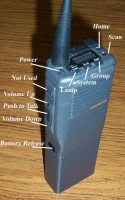
RX sensitivity on the low end with Kenwood's is pretty bad, pretty much unusable without a filter change even with a slight alligator repeater. On Kenwood's they are programmed by FCC channel number. The trick is to use FCC channel number 200 in all systems. This will indicate frequency 937.5000. You save this file and exit the Kenwood KPG-35D program. Run a custom program, (Kenwood3.exe) and or a bit of hex editing to be able to use it in the ham band. If you use Pete's KW900EZP program then you can forget about the manual hex edit, as it is done for you. There is really no way to change the commercial -39 MHz slit for duplex operation. The only way to really use these for duplex is load all of the transmit frequencies should be into one system, each receive frequency will be an individual systems. Select "Last Used" in the program. Select the transmit system and the repeater input you want, turn on the scan and you are ready to transmit. Let up on PTT and the radio scans to the repeater output. The TK-431 and TK-941 (mobile) are the least user friendly for the 900MHz band.
Kenwood TK981 Mobile
No mods really necessary or filter changes for 902 or 927 TX only, and 927
rx only. This a 15 watt radio.
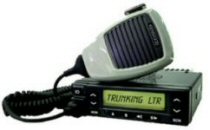
On Kenwood's they are programmed by FCC channel number. The trick is to use FCC channel number 200 in all systems. This will indicate frequency 937.5000. You save this file and exit Kenwood's KPG-49D programming software Run a custom program such as the KW900EZP, and or a bit of hex editing to be able to use it in the ham band. In all other Kenwood's there is really no way to change the commercial -39 MHz slit for duplex operation. They have cracked this problem with the TK-481/TK-981 using the KW900EZP program, as it explains the "workaround" for this with this particular radio. If your going Kenwood this radio and the TK481 are your best plug and play bet.
Without filter changes squelch typically breaks at 0.14 uV on the high end of the band and full quieting at 3.97 uV. To use this radio for anything other than a 25MHz split, you might have to tweak the VCO to get it to RX below the 927. The sensitivity will be a less due to the RX filters. But filters for the 941, 980, & 981 are available from Digikey.
GE Custom MVP Mobile (also GE Mastr II, exec II)
Modifications Necessary. But outstanding on 900 MHz, and durable for
use in a repeater. Change of 6 cap's and a clip of 1/2 turn off of a
couple helical resonators on the exciter and the radio is good to go. No filter
change needed for high or low frequencies. The MVP is a bit more trouble
but is worth it if you need the extra power.
GE-MPA Portable (P400 is the Euro version of the MP-A)
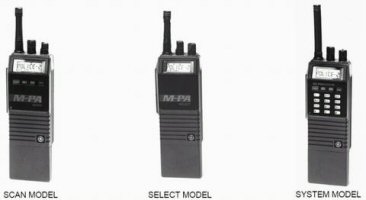
900 MHz MTL (or M-PA) portable radio, is supposedly operational on the
902/927 amateur band with minimal effort and no hardware mods. See
these notes. Typically exhibits .25uV at 927.5 MHz.
GE/Ericsson MDX Mobile
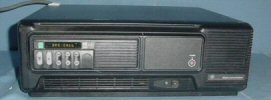
GE MDX's can be converted to do 900 ham with a plug-in module/micro
processor from Doug Bade, KB8GVQ. He has provisions for 12 and
25/26MHz splits. The radio receives fine on band edges without filter
changes. They are 16 and 128 channel versions of this radio. http://www.ohioaprs.net/files/doug/GE_MDX_900_Conversion/
GE/Ericsson 900 MHz MTD EDACS Mobile
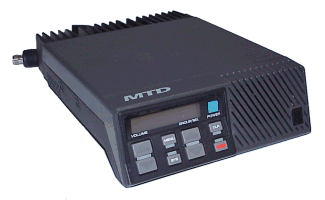
The 900 MHz MTD EDACS mobiles, predate the MDX series, and have a very similar design. Doug's board also works on this variant.
http://www.ohioaprs.net/files/doug/GE_MDX_900_Conversion/
Uniden Mobile Models: SMS925TS and SMS935TS
Programmable using the Uniden AMX791 software. Someone changed the IF
freq so it would work with a 25mhz offset for repeaters, but using Aux. Micro Processor in between the
radio's Micro Proc. and the PLL syn. chip sounds like the best answer. See
this note
Note the SMS930TS will not do conventional, trunking only. SMS925TS and SMS935TS will do conventional. Getting them to TX > 902 MHz is a simple edit of the hex values in the customer info file, but no one has yet hacked the firmware to change RX to a 25 MHz split.
Maxon TP-4901 Portable
Hex editing the TP-4901 dat file. You may be only achieve low end (up
to 910 MHz) programming with the Maxon.
EF Johnson 242-8655 / EF Johnson 242-8640
There is a a replacement microprocessor out there for these. Swap the uP, and one
SMD chip cap, and reprogram!
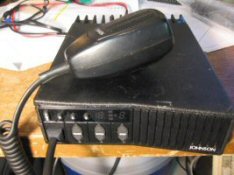
See EFJohnson.txt. Also see K0KN's notes N2MCI's notes
Johnson 864x Conversion to the Ham Band
http://www.repeater-builder.com/johnson/efj-index.html
Standard GX5850T
![]()
The data is stored in FCC channel numbers, but so far it seems to be capable
of using their number scheme and just adjusting for the shift. For example, in
hex, the FCC channel #320 is 0140. In the .DA5 data file, the
"Tag" entries in the software mark the beginning and end of the
channel data, so they make things easy. That being said, FCC channel numbers are
simply 0.0125 steps, just do a little math and figure that if FCC#320=900mhz,
then FCC#519=902.4875mhz(hex=0207). There are separate entries for RX then TX
for each conventional channel.
These radios are set to a -39mhz split, so you have to use the old scan trick to
use with a repeater. Using the simplex check box in the RSS, these radios will
TX all the way from 896-939 MHz. Changing receive filters exhibits no
change in sensitivity.
See KG4JYE's notes: Standard GX5850 Notes.pdf
DEMI 10 watt 900 MHz Transverter
See: http://downeastmicrowave.com/Catalog.htm#BM33cm
Available in many different forms: $395 built, $195-295 kit form
Granger 900 MHz Repeater
19 inch rackmount, 5 watt system, includes duplexer (6 cavity bandpass)
Requires recrystalization explained on webpage see: http://www.eaznet.com/~skyisl/granger.html
TAIT T800 Series Repeater
They are ROM/Dipswitch programmable anywhere in the 902-928 band TX and
RX. 5 Watts output (adjustable), .25ish uV RX or better in most
cases. 600 ohm balanced line in and out
cor/ptt at logic low. http://www.taitworld.com/main/index.cfm/1,241,0,44,html
Hamtronics TB901 & R901
TB901 single
channel exciter (~400mW), R901
single channel receiver with sharp front end
For .2 uv receive sensitivity. and 20 watts out you will need about 20' vertical separation. You will always be better with vertical separation. To achieve 90db isolation at 902MHz will require about 40' vertical separation. It would take about 3000' horizontal separation to achieve the same isolation.
Tx Rx Systems 4 cavity Bp Br Duplexers Model 28-88-0101. It appears to be same as Model 28-88-01A and Model 28-88-01B which is rated at 125w with 3.9 MHz split or 600w with 39MHz split. See: http://www.txrx.com/product/product.aspx?UID=5acfd75f-b8a1-40ab-bb57-73177b5b4307 These tune up really easy for 25 or 12 MHz splits with ease.
The Wacom WP-687 duplexor can work by changing the cable lengths. Expect about 82-86 dB isolation per side.
See: http://www.ham-radio.com/wb6zsu/components/duplexer/duplexer.html
and http://www.fitzharris.com/wacom/
Tx Rx Systems Inc. Band Pass Circuit 890-960 MHz is rated at 600 watts, Serial #: 256-81-A14 26-88-01A. Works just fine with a 25 MHz split. http://www.txrx.com/product/product_view.aspx?UID=28D8DC1C-F6D2-4811-A49E-3D926A19A37C
If you do choose to go with a 12 M split, duplexers are available, but not as
plentiful. The Sinclair MR456 series is available as close as 9 MHz, The Q4220E
series as close as 3.6 MHz. There are models from most manufacturers.
6 dBd 915 MHz J-pole antenna - Plans
Mendelson's has 900 MHz omni directional antennas 16' with 10 dBd gain.
Andrews ASP-977 Vari-tilt 14' with 8.5-10 dBd gain
Comet CDC7-71 900 MHz omni directional antenna 54" with 7.4db gain
Comet KP-20 900 MHz omni directional antenna 96" with 9.2 dBi gain
As well as numerous commercial antennas from paging systems. Antennas at 900 MHz are pretty broad-banded. For mobile use, Comtelco Microloss 900 are good. Antenex also has some models for 900 MHz.
Obviously always try and use the lowest loss feedline and connectors. The UHF
connector (PL-259), should be avoided as loss at 900 MHz could be near 2 dB.
RG-58/AU is also not desirable. Here are some losses per 100 feet: RG-58/AU 16.5 dB,
RG-8/AU 8 dB, Belden 9913 4.2 dB, LMR-400 3.9 dB, LMR-600 2.50 dB,
LDF 2-50 (3/8" heliax) 3.22 dB, LDF 4-50A (1/2" heliax) 2.22 dB. LMR-195
10.7 dB, LMR-240 7.6 dB, LMR-200MA 9.89 dB (same dimensions as RG-58).
To maintain transmitter / receiver isolation in cabinet jumpers for repeaters should be made from double shielded teflon coax. RG-142 (similar loss and size to RG-58), is fine for receive lines. However at higher power levels you should use RG-393 (similar loss & size to RG-8). Else consider 1/2" superflex jumpers.
-Motorola STF2520A.900MHz 150 Watt Linear Power Amplifier
This is a linear power amplifier used in an AMPS (or CDMA ?) cellular telephone system. It is listed as FINAL AMP LOW POWER. But, would make a great amateur 902 or 903 MHz linear for moonbounce, repeater use, etc. Has two stages of gain, first is MRF897, the final stage is a MOT MRF899. The final is rated at 150 watt (PEP) output in class AB service. Power supply required is approx. 26VDC @ 15A. Connector panel is just a drop-in plate and is easily replaced with a customized unit. The circulator on the output is spec'd to 904 MHz, so should work for 902 or 903 OK. Layout of the RF section is quite straight forward with just Vcc, bias, and I/O connections. Reports indicate that you can get 100 watts out with just a couple of watts input. Check out the VHFSouth website for their modification of this amplifier. Unit weighs 8.5 pounds and is almost all cast aluminum. The transistors are soldered to a copper heat spreader (that is the same size as the white substrate) that is screwed to the heat sink. It uses a single stage amplifier with the isolator separated from the main board. Unlike the other amps this isolator can be easily tuned with a magnet or bypassed altogether. In this case this amp will work very well for a repeater amp on 927 MHz.
-Motorola SGTF1020B 900MHz 150 Watt Linear Power Amplifier.
This amp uses a single MRF897 driver and a MRF899 final amplifier board. The power output is close to 150W on 902 with approx 5-7 W drive. The power output drops a lot going up in frequency, and it does not appear suitable for 927 MHz. Power supply required is approx. 26VDC @ 15A. See: http://www.ac6dd.com/amplifiers/smallmotorola/smallmotorola.htm
-Motorola SGTF1038A 900 MHz 300 watt linear power amplifier
This is a linear power amplifier used in an AMPS (or CDMA ?) cellular telephone system. It is listed as FINAL AMP HI POWER. But, would make a great amateur 902 MHz linear for moonbounce, etc. Has two sets of two stages of gain, first is MRF897 and final is MOT MRF899. Each final is rated at 150 watt (PEP) output in class AB service. Power supply required is approx. 26VDC @ 30A. Connector panel is just a drop-in plate and is easily replaced with a customized unit. The circulator on the output is spec'd to 904 MHz. Layout of the RF section is quite straight forward with just Vcc, bias, and I/O connections. Probably does not take more than several watts to drive this thing to full output. Unit weighs 10 pounds and is almost all cast aluminum. The transistors are soldered to a copper heat spreader (that is the same size as the white substrate) that is screwed to the heat sink.
-PURC 5000 Driver Power Amplifier. (C85JLB Series)
It requires only about 4 watts for max power output ~90 watts. With a 2.5 watt drive expect ~36 watts. The DPA will work fine on 900 MHz without any mods. (The PURC5000 was a retrofitted MSF5000, primarily used as a paging transmitter. Both of my stations require the suitcase to program. They are rumors they will work on the ham band. All the PURCs take a PROM. Some MSFs do and some don't.) Using something like the Maxtrac to drive just the PURC's DPA is the way to go rather than attempting to use the whole thing.
http://www.ac6dd.com/amplifiers/elpa/elpa.htm
TPL Communications has a few amplifiers that cover 900 MHz. PA8-1AA-RS 1-3w drive = 10-20out. PA8-1AB-RS 2-5w drive = 20-35out. PA8-1AC-RXRF 5w drive= 35-75out. PA8-1DD-RXRF 5-15w drive = 50-80out.
TE Systems also has a few amplifiers that cover 900 MHz. 8914FRN 2-5w drive = 80-100 out. 8914GRN 5-10w drive = 80-100 out.
Downeast Microwave has a 40W & 70W Linear Amplifier.
A Milcom 800 MHz amplifier(P9-05K1-C1)/Uniden ARX 900 runs off 13.8 volts and takes 400 mw to drive it to 100 watts for 900 MHz.
If your interested in Amateur Television applications for this band, check out P.C. Electronics.
There have been a couple frequency hopping spread spectrum radios for 900 MHz.
Motorola DTR650
Apparently Motorola has repackaged their off network iDen 900 MHz ISM FHSS
walkie talkie feature into a simplex radio. Range is actually 1/2 way decent on
them from what I've seen, couple miles line of sight. It has a removable
antenna. The price is around $300
TriSquare eXRS Radios <http://www.trisquare.us/>
906 to 923.75 MHz, 50 hopping channels (there is the possibility of 10 billion
different hoping sequence or spreading codes), 1 watt power, -124 dBm
receive sensitivity, 397 ms. dwell time, 11.5
KHz occupied bandwidth. Integrated antenna, but can be modified with an SMA
connector. Nothing to compare with the Motorola DTR radios. Nowhere
near the price of around $50 either. Blog
overview and performance report.
Using Part 15 Wireless Ethernet Devices For Amateur Radio
Aerocomm 900 MHz ConnexLink radios - 1 watt FHSS, data
transmissions of up to 115.2Kbps., under $100
Hacking the original 900 MHz WaveLAN
- 1 watt, 2 Mbps DSSS
Name Description ./
481a.exe Utility to show frequency for TK481 900c.jpg 900mhz low cost duplexer design sketch Freqin.exe a simple program for converting frequencies to FCC numbers for Kenwood & EF Johnson Kenwood3.exe Freq to Hex for Kenwood TK; 431, 930, 931, and 941 Knwdburn.zip Allows the Kenwood TK-931 mobile to be used on the 902 to 927 MHz HAM band with 12 and 25 MHz repeater splits. KNWDBURN is a Full Ham replacement program for the TK-931 only / so far.. It replaces using the normal KPG5D programming software. KW900EZP.EXE Auto binary file converter for Kenwood TK; 431, 931, 941, and TK 481/981 toko915.jpg TOKO 915 MHz RX filters, 6DFB-915E-10 and 4DFB-915E-10 for MaxTracs and Kenwoods tk930.txt basics / how-to for this 800 MHz radio maxtrac mods.txt Info and description on 900 Maxtrac VCO Mods MICOR_800MHz-to-927MHz.jpg Where to cut in the controlled stage MICOR_800MHz-to-927MHz1.jpg Where to cut in the pre-driver stage micor.txt Micor 800 MHz to 927 MHz conversion notes mm900pic.zip 900 MHz Maxtrac modification pictures GTX_squelch_detect.jpg where to pick off HISQDET (~6.6vdc) in the GTX mobiles gtx900a-COR.jpg alternative location to pick COR off (Active low) GTX-PAschematic.jpg power control main board gtx-notes.txt gtx power control & other notes 900_receive_specs.txt RX performance notes within the ham band on commercial modified gear (mirrored from various sources)